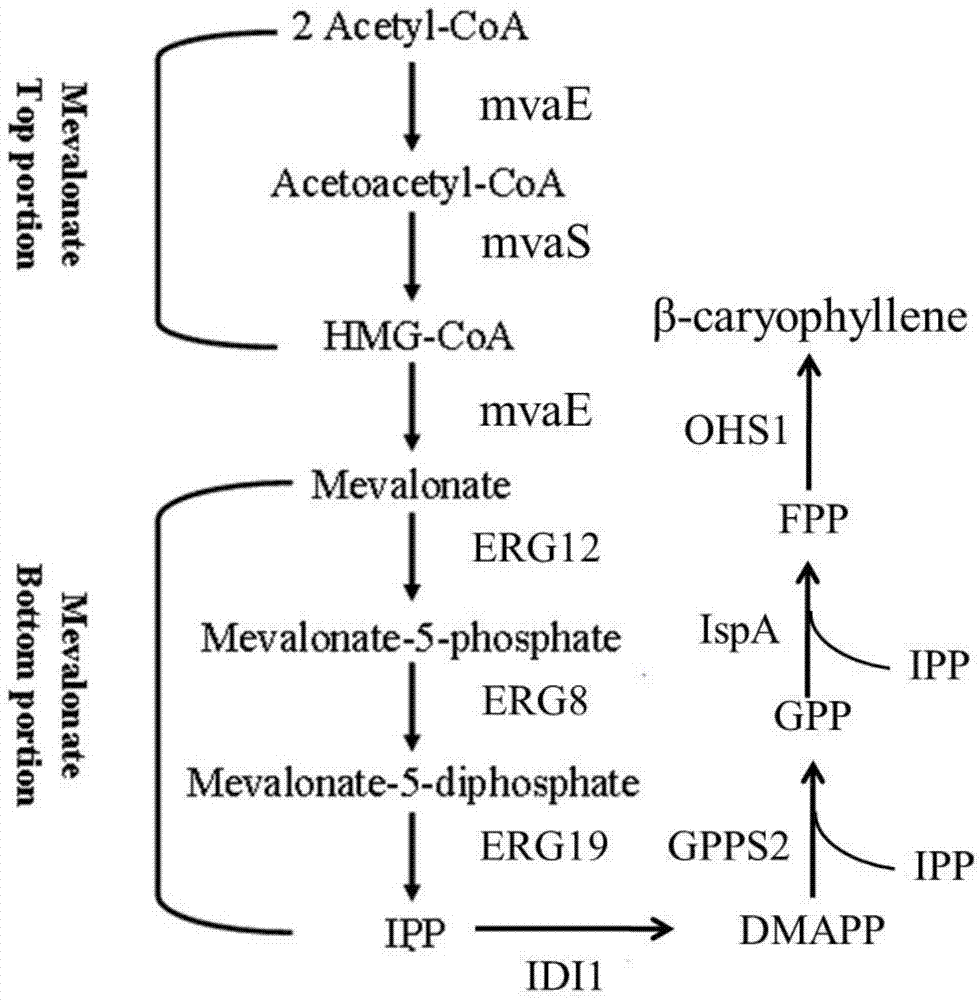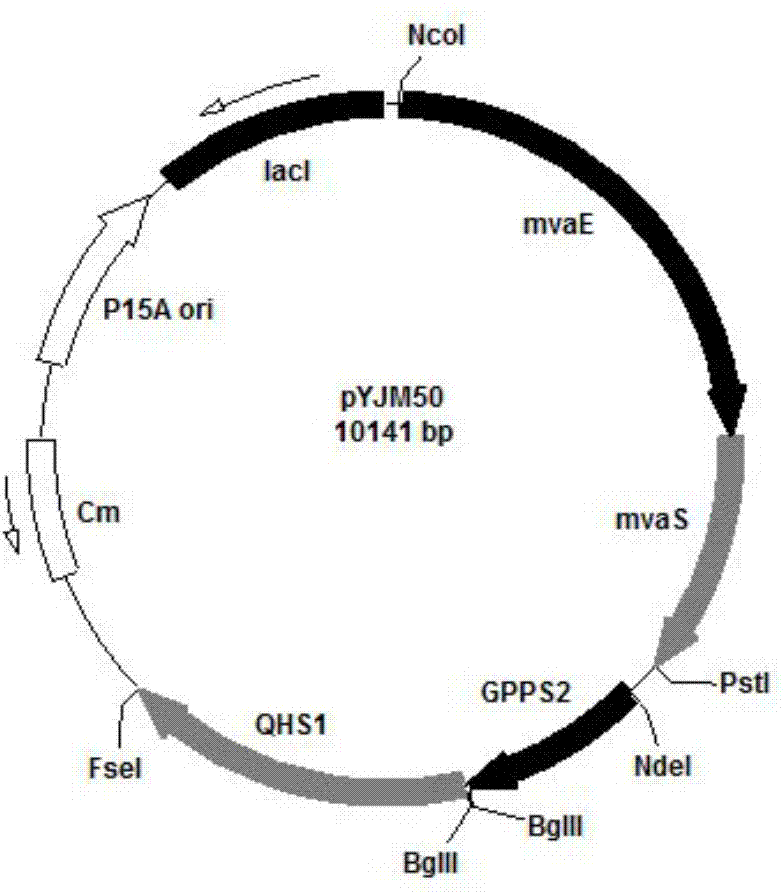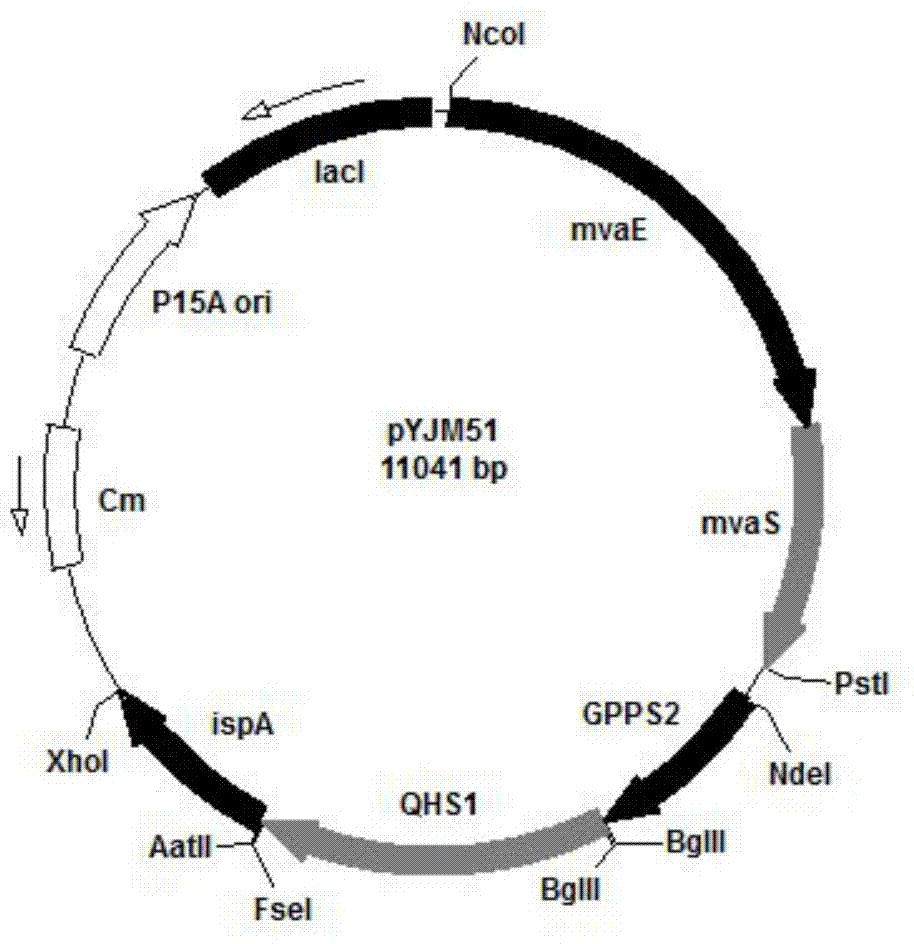A method of synthesizing beta-caryophyllene by microbial catalysis and a reconstituted cell capable of synthesizing the beta-caryophyllene
A technology for recombining cells and caryophyllene, which is applied in the direction of recombinant DNA technology, bacteria, and the use of vectors to introduce foreign genetic material, etc.
- Summary
- Abstract
- Description
- Claims
- Application Information
AI Technical Summary
Problems solved by technology
Method used
Image
Examples
Embodiment 1
[0035] By co-expressing the acetyl-CoA acyltransferase gene / hydroxymethylglutaryl-CoA reductase gene (mvaE) from Enterococcus faecalis in Escherichia coli, 3-hydroxy-3-methylglutaryl Acyl-CoA synthase gene (mvaS); mevalonate kinase gene (ERG12) from Saccharomyces cerevisiae, mevalonate-5-phosphate kinase gene (ERG8), mevalonate-5- Diphosphate decarboxylase gene (ERG19), isopentenyl pyrophosphate isomerase gene (IDI1); geranyl diphosphate synthase gene (GPPS2) derived from North American fir (Abies grandis); derived from Neurospora crassa ( The farnesyl pyrophosphate synthase gene (FPPS) from Neurospora crassa and the β-caryophyllene synthase gene (QHS1) from Artemisia annua can biosynthesize isoprene from glucose degradation intermediate acetyl-CoA Derivatives - β-caryophyllene.
[0036] 1.1 Cloning of foreign genes and construction of expression vectors
[0037] 1.1.1 Cloning of foreign genes
[0038] 1.1.1.1 Cloning of genes in the upper metabolic pathway of Enterococcus ...
Embodiment 2
[0066] The constructed plasmid was transformed into competent cells, and the recombinant bacteria were fermented and cultured by shaking flask fermentation and fermenter fermentation, and the fermentation products were detected qualitatively and quantitatively by gas chromatography.
[0067] 2.1 Construction of E.coli recombinant strain
[0068] Transform E.coli BL21 (DE3) competent cells with pYJM51 (pACY-mvaE-mvaS-GPPS2-QHS1-ispA) and pYJM14 (pTrc-low) recombinant plasmids together by heat shock, and apply to the cells added with chloramphenicol and ampicillin The LB solid plate of prime antibiotics was used to obtain positive clones by PCR screening, thereby obtaining engineering Escherichia coli containing pYJM51 and pYJM14.
[0069] 2.2 Cultivation of engineering Escherichia coli
[0070] Inoculate the activated engineering Escherichia coli into the LB liquid culture solution containing chloramphenicol and ampicillin at a ratio of 1:100, and culture it with shaking at 37...
Embodiment 3
[0079]Different fermentation conditions, such as induction temperature, rotation speed, inducer concentration, nitrogen source, substrate concentration, medium pH value and composition ratio, etc., will affect the yield of the fermentation product pinene. This patent detects the effects of different induction temperatures, inducer concentrations and nitrogen sources on the production of β-caryophyllene.
[0080] 3.1 Construction of E.coli recombinant strain
[0081] Transform E.coli BL21 (DE3) competent cells with pYJM51 (pACY-mvaE-mvaS-GPPS2-QHS1-ispA) and pYJM14 (pTrc-low) recombinant plasmids together by heat shock, and apply to the cells added with chloramphenicol and ampicillin The LB solid plate of antibiotic antibiotics was used to obtain positive clones by PCR screening, thereby obtaining engineering Escherichia coli containing pYJM27 and pYJM14.
[0082] 3.2 Study the effect of different induction temperatures on the yield of β-caryophyllene
[0083] Pick a single c...
PUM
 Login to View More
Login to View More Abstract
Description
Claims
Application Information
 Login to View More
Login to View More - R&D
- Intellectual Property
- Life Sciences
- Materials
- Tech Scout
- Unparalleled Data Quality
- Higher Quality Content
- 60% Fewer Hallucinations
Browse by: Latest US Patents, China's latest patents, Technical Efficacy Thesaurus, Application Domain, Technology Topic, Popular Technical Reports.
© 2025 PatSnap. All rights reserved.Legal|Privacy policy|Modern Slavery Act Transparency Statement|Sitemap|About US| Contact US: help@patsnap.com



